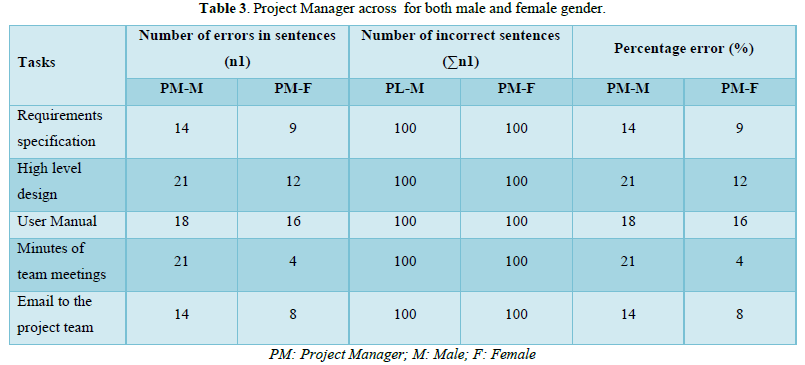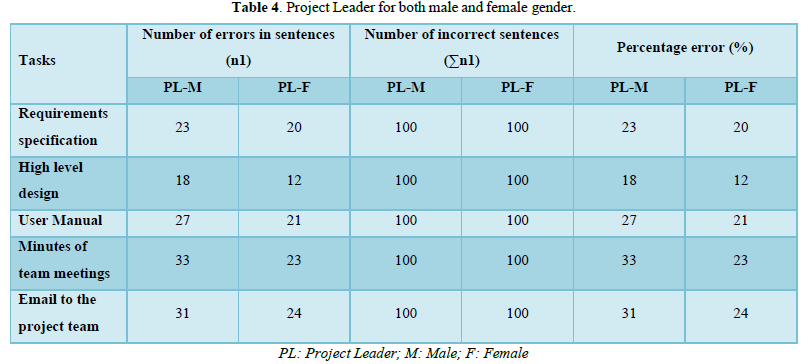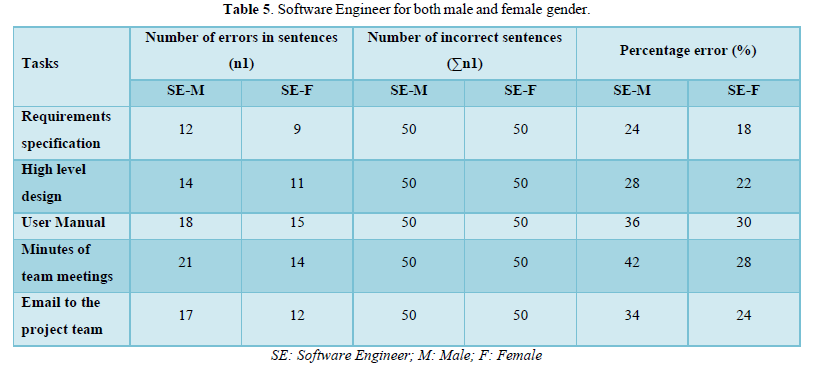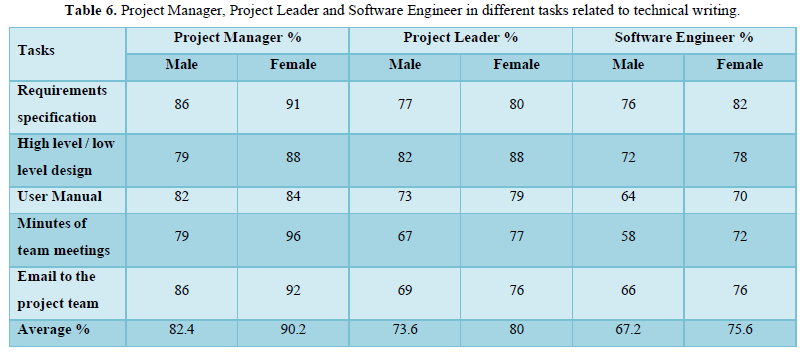283
Views & Citations10
Likes & Shares
The purpose of this study is to test and evaluate the English technical writing skills of human resources in IT sector. In order to test the human resources technical writing skills in English, they are divided into three groups according to their job role-Project Manager, Project Leader and Software Engineer. The human resources communicate about the technical aspects of their project and this has been evaluated for the present study.
Keywords: Communicative competence, Communication skills, Domain knowledge, Human resources, Information technology, Technical writing, Technical specifications
The objectives of the present study include:
- To ascertain the employee’s ability in developing English vocabulary during writing
- To ascertain their level of technical writing skills in English
RELATED WORK
There are no direct references pertaining for the present study. However, the article does refer to other works done on a general topic pertaining to writing skills. Written communication is another powerful method of communication. The power of writing is eloquently expressed in the saying ‘the pen is mightier than the sword’. Written communication has come to acquire great significance in the lives of individuals as well as IT organizations. Writing skills and word-power of the person writing the document come into play in making the written communication forceful and effective [2,3]. Written communication invariably creates a record that can be preserved over time. Letters, memos, contracts, agreements, technical documents and reports often carry time value and need to be stored and preserved. As a result, it becomes possible to access them for reference or study. IT organizations rely more on records and written documents rather than oral commitments. Documentation of knowledge and experience facilitates institutionalization of an organization’s IT project. In IT sector, the technical documents are prepared based on the needs to international standards like ISO 9001, ISO 20000, ISO 27001 and Capability Maturity Model Integrated administered by Software Engineering Institute (SEI), Pittsburgh. All the IT organizations prepare the technical documents using a structured template. The human resources working in the IT project will prepare the documents.
The collection of words that are arranged in the right order is called a sentence. It is the largest grammatical unit. It consists of a subject, a verb and an object or a complement.
Subject: Denotes a person, place or a thing
Verb: Denotes action
Object: Denotes the thing or person on whom the action is directed to
Direct Object: Denotes the noun which is answerable to “What” or “which”
Indirect Object: Denotes the noun which is answerable to the question “To Whom”
Adverb: Gives additional information as to Where, how and When something happened
Compliment: Subject compliments come after an intransitive verb
A sentence has two main parts. A subject and a predicate. Subject is whom or which the sentence talks about. Predicate tells something about the subject. The subject usually begins the sentence.
Below example, provides the details of a meeting that took place in an IT organization.
- How to reduce power consumption in office?
- Office to work for six days a week
- Dependence on computer adversely affects the health of the office staff. How to avoid it?
Project Manager: Hello Team, we have gathered here to discuss power consumption in our office and how to lessen it [4].
Project Leader: Srini, it is a good idea.
Software Engineer: We can try changing the working hours too. Project Leader: Fan is necessary but we can give up the air conditioner. Project Manager: I think it is a better option to use an inverter too.
Project Leader: Most of all we must turn off everything when it is not used. Software Engineer: LED lights are very cheap in consumption; shall we opt for that? Project Manager: Thank you team for all your valuable suggestions.
The verbal communications during the meeting needs to be drawn as Minutes of Meeting and circulated to all stakeholders. This will enable the team to follow up on the action to be taken and also to monitor the effectiveness of the corrective actions.
Similarly, in case of written communication, it needs to be concise and precise. For example, the below letter was sent to the vendor regarding a defective printer purchased by an IT organization.
“We purchased a printer from you last month. It was defective and so we returned it for sending us a replacement of the same model. The replaced printer is also defective”.
In the above letter, the stated facts are generic. It does not provide details pertaining to the model number of the printer, date of purchase of the original printer, when the first replacement was received, invoice number and the name of the support engineer who configured the printer. Also, at the conclusion part of the letter, the organization should specifically state that the vendor should treat this as an urgent request and provide the replacement within a specified time. Another example, the researcher would like to quote is from an email sent to vendor [5,6]. The email text is written as “printer not working” as subject of email. The body of the mail was written as “Printer not working. Please replace the printer”. The email does not specify about the printer model and date of purchase. The technical details are not clearly specified and the vendor will not be in a position to provide the required service. One more aspect is that the vocabulary used should be relevant to the context of the subject matter. The same word should not be repeated throughout. Vocabulary development is a skill that needs to be developed by all individuals.
In the above example, the sentences are structured without referring to the facts which are essential attributes of a written communication.
Skills relevant to business organizations are also classified into three other broad groups. They are (a) technical (b) human and (c) conceptual. Technical skills relate to knowledge, proficiency, expertise, speed, accuracy, and the like. These are often specific to the area of operation. These refer to what is called the domain knowledge. Technical skills are a must for Project Leader and Software Engineer. Human skills relate to inter-personal skills and group skills. Human skills are associated with networking and managing relationships. These would include writing, speaking and presentation skills, motivational skills and team building skills. These are relevant across all levels of management. The next set of skills is conceptual skills. Conceptual skills are relatively higher order skills. They include vision building and strategy formulation skills, conflict management skills, problem solving skills and decision-making skills. These are particularly essential for Project Manager and senior management levels [7].
The development of communication skills is a continuous process. It comes from adapting a mix of approaches. It results from not only theoretical study and bookish knowledge, but also from observation, practice and real-life handling of situations. Confidence comes from practice. A person who has written a few technical documents (around six) is more confident than the one who has written just two. Similarly, a person who has made many presentations (around six) is better than the one who has made just two. Skill development is a process of continuous learning. Learning happens in several ways. They include (a) class room learning (b) distance learning (c) on-line learning (d) case studies and exercises (e) seminars and workshops and (f) on-the-job learning.
Communication theorist Harold D. Laswell developed a theory of communication where he emphasized the behavioral aspects of the sender. His model of communication had five elements viz [8]. Who says what, through which channel, to whom and with what effect? The model explains how the communication process is coded.
WRITING SKILLS
Writing skill is an essential component for the human resources working in IT sector. Writing skills test the ability to frame correct sentences with a proper usage of grammar. Generally, the practice of an employee will write something about his/her work and submit to his/her superior in an organization without too much emphasis on grammar and sentence structure. Writing was more informal in nature. Writing was not considered as an important skill and it was more of providing answers to a set of questions, which is akin to a discourse. Like speaking and listening, writing is a productive skill. It involves the production of language by one person and received/read by the other [9]. During the writing process, message is communicated to the intended set of recipients. In order to write, the employees need to understand the words, sentences and the combination of sentences that link together to communicate a message. Learning to write in English language is not merely writing a set of words that represents the utterances one has in mind, but also involves organization of ideas, facts and issues in a sequential manner. The words used should be appropriate and the sentences should express the exact fact or an issue with grammatical and orthographic accuracy. Therefore, one can infer that learning to write involves the learning to use grammar with ease in an orderly manner. For example, the below sentence;
“Though the Printed Circuit Board (PCB) had an issue, it is working not properly”:
The above sentence can be written in any of the forms as shown below;
- Although the PCB had a problem, it is not working properly
- Despite the PCB having an issue, it is not functioning properly
- The PCB had an issue, but it isn't functioning properly
- Even though the PCB has an issue, it isn't working properly
- Despite the PCB issue, it's not working properly
- However, the PCB is not working properly even though it had an issue
- Despite the PCB's issue, it works poorly
- In spite of the problem with the PCB, it has not worked properly
- Even though the PCB had a problem, it does not work as expected
- Despite the problem on the PCB, it is not working properly
From the above sentence one can infer the following meanings. Also, the sentence does not convey the correct meaning and a reader cannot understand the issue/problem associated with the PCB
- Printed Circuit Board (PCB) has an issue
- It’s not working properly
The use of the word “working” at the end of a sentence implies that the PCB is working. However, the word “not” is qualified to mean that it is not working properly.
The sentence mentioned in the example can be rephrased in a different manner as shown below to infer a clear meaning;
- Since the PCB has an issue, it’s not functioning properly
- The PCB has an issue, so it's not functioning properly
- As a result of an issue with the PCB, it isn't working correctly
- There is a problem with the PCB, so the device is not working properly
- It is not functioning properly because the PCB has a problem
- Due to an issue with the PCB, the device doesn't function properly
- The PCB isn't working properly since there's a problem
- The device is not functioning properly since its PCB is faulty
- A problem on the PCB is preventing the device from functioning correctly
- The PCB has an issue, so the device does not function properly
- Having a problem with the PCB prevents it from functioning properly
Based on the above example, it can be inferred that writing skill is required to communicate with other people, to understand the intent, talk to the concerned people, read what others have written and provide reply to them. The sub skills of writing include the following elements
- Plan
- Organize (Layout, body of the letter or notes)
- Check (Grammar, Paragraph, Punctuation, Linking the content)
- Act (Send to the recipient)
Writing is a productive skill referring to the expression of ideas in a consecutive way according to graphic conventions of the language (Rivers, 1968). It is highly effective and advanced mode of human communication involving the interaction of hand movements and mind. The development of writing skill presupposes listening and reading and includes a wide range of areas right from the onset of writing a document.
The achievement and errors in writing of the human resources included in the study are dealt with in this paper. The different tasks of technical writing used in this study are:
- Preparation of requirements specification
- Design document
- User manual
- Minutes of team meetings
- Email to the project team
- Vocabulary usage
RESEARCH METHODOLOGY
This study was done with 180 human resources in Chennai. The selection of the resources was done though random sampling method.
Though there are many IT companies in Tier II and Tier III band, not many were willing to be part of the study. Hence only nine companies were selected for the study with the following criteria.
- Tier II companies providing software development and maintenance = 4
- Tier III companies providing application support and maintenance = 5
From the nine companies, 20 human resources comprising of male and female from every company were selected randomly [10]. Thus 180 employees were selected from nine organizations. The ratio of male and female will vary across job roles.
The English writing skills among the employees were checked based on the technical documents prepared by them and emails exchanged internally between the team.
Table 1 below shows the distribution of sample across four variables such as
- Gender
- Job Role
- Native Language (mother tongue)
- Work experience

LIMITATION OF THE STUDY
Learning can occur both inside and outside an organization. Human Resources learn basic English language skills which includes reading, speaking and writing during their school education and graduation. They also do self-learning through external training and online education portals [11]. This study assumes that English language competence is derived from the formal education provided to them during their school education and graduation.
DATA COLLECTION AND SAMPLE SIZE
The researcher has chosen sample size of 180 persons from nine IT companies in Chennai. From the nine companies, 20 human resources comprising of male and female from every company were randomly selected. One hundred and fifty sentences of project managers and project leaders and one hundred sentences of software engineers were analyzed and the errors were identified. Since project managers and project leaders prepare more number of documents, 150 sentences were analyzed. Software engineers prepare relatively less number of documents and hence 50 sentences were analyzed.
DATA ANALYSIS
Primary data was collected from the respondents comprising of both genders based in Chennai. Table 2 below provides details of the documents that were prepared by Project Managers, Project Leaders and Software Engineers every month. Post COVID, the number of technical documents that needs to be written have increased.

From the above Table 2 it can be inferred that Software Engineers and Project Leaders prepares a large number of technical documents followed by Project Managers [12]. The number of technical documents prepared by Software Engineers after COVID crisis have increased.
All software projects follow a typical life cycle and the documents are prepared based on the various phases in the life cycle. Coding phase does not involve a specific document but when the business logic is changed, the details of the changes are incorporated and commented inside the source code. Here also technical writing skills have an important role. If the software engineer does not provide the details precisely, it will be difficult to understand as to why the changes were carried out in the source code.
A total of 150 sentences were analyzed from the documents prepared by project managers and project leaders, errors were identified in 100 sentences. Similarly, for software engineers, 50 sentences were analyzed and errors were identified in all the 50 sentences. The errors found were pertaining to missing or incorrect letters, sentence construction, usage of words and grammar.
The sentence error was calculated using the formula;
Where P: percentage error; n1: number of errors in sentences; ∑n1: total number of incorrect sentences
Project Manager
The errors found are tabulated in Table 3 below for the Project Manager across for both male and female gender.

Project Leader
The errors found are tabulated in Table 4 below for the Project Leader for both male and female gender.

Software Engineer
The errors found are tabulated in Table 5 below for Software Engineer for both male and female gender.

The percentage of the scores achieved by the Project Manager, Project Leader and Software Engineer in different tasks related to technical writing is given in Table 6 below.

It can be inferred from Table 6 that in all the tasks female human resources across all job roles showed better performance as compared to male. The value underlined highlights the deviation between male and female gender which are close to 10 or above 10%. The challenge faced by male project managers pertain to the preparation of high level /low level design documents and minutes of team meetings. In case of male project leaders, their challenges are in the preparation of minutes of team meeting. Software engineers faces challenge in preparation of minutes of team meeting and sending email to the project team.
Another observation is that female project managers have excelled with an average of 90.2% while male project managers average was 82.4%. Similarly, female project leaders secured a score 80% and male project leaders secured 73.6%. In the category of software engineers, 75.6% score was secured by female and 67.2% score was secured by male.
The gap observed in writing between the expected score (100%) and the actual score for all the human resources in different job roles is related to the errors found in their tasks. The types of errors and the corresponding frequency found in technical writing are discussed in this paper.
SUMMARY AND CONCLUSION
This study shows that the human resources in IT sector possess varied levels of writing skill in English. It is to be noted that Tamil is the native language (mother tongue) for all the resources in the category of Project Managers and Project Leaders. They gained language competency on the job and were able to handle the tasks properly. The average percentage of female gender across all job roles in different tasks related to technical writing were higher compared to male gender. The gap in the writing scores can be attributed to lack of reading and familiarity with words. Writing is a skill which can be mastered over a period of time and there cannot be a fixed template for writing. Writing is based on the current facts/issue and accordingly it has to be documented. This requires a clear understanding of the issue which translates into sentences. One can administer any methodology to test the writing skills of the human resources. But the end objective is that they should be able to handle their job with ease. There cannot be a structured framework and curriculum design for testing English writing skills. Though all the human resources possess engineering /computer science background, they wrote answers to a set of questions in the examination. Technical facts are dynamic and keep changing every day in IT sector. Hence technical writing requires a different skill which can be gained over a period of time. Training alone will not enable an individual to hone his/her writing skills. There should be a continuous reading to enrich one’s vocabulary and an ability to listen to what others say. Writing is a process which involves understanding the facts, synthesize the words and construct meaningful sentences. Human resources working in all job roles in IT sector should have a flair for writing in order to improve their writing skills. Technical writing is not an easy task since all the relevant facts need to be included in a simple manner which can be understood by the reader. In all the documents the words frequently used were “because, thus, gives, sit, very well” [10,11]. It can be stated that writing develops linguistic competence of the human resources. Technical writing needs to be practiced in order to produce a readable and understandable output. Vocabulary development depends on number of factors which includes experience, frequent reading, understanding the word in its context and the ability to use the word appropriately. The study was undertaken with the aim of finding out the role of linguistic and communicative competence of human resources in IT sector.
Technical writing in English serves as an essential mechanism for communicating the technical aspects of the software project in a more logical manner by using technical words. Technical words in IT sector means printer, router firewall, database, design, code, web service etc., Technical writing in English, in the field of Information Technology (IT) requires specific sets of vocabulary. Human resources working in IT/software projects need to have good technical writing skills in the preparation of reports, presentations, documentations, etc. Technical writing in English is used for a specific purpose, and hence it needs to be precise and the sentences should have clarity. Each technical document contains a set of technical information and writing skill will also vary depending on the information that is required to be included in the document [12]. The Requirements Traceability Matrix (RTM) document will map the given requirements across the software development life cycle till the testing phase. In IT sector, human resources working in projects prepare technical reports by inferring data from graphs and charts. Technical writing should be succinct and lucid and message should be conveyed in a proper perspective to the reader. In IT sector the reader of the message is the customer and project team. This paper highlights the above ideas with examples, besides explaining the various writing skills required in the field of Information Technology.
- Bennet A, & Slaughter H (1984) Sociolinguistic/discourse approach to the description of the communicative competence of linguistic minority children. In C Rivera An Ethnographic/Sociolinguistic Approach to Language Proficiency Assessment. Clevedon Avon: Multilingual Matters.
- Courtland BL, Thill JV (2007) Business Communication Today 4th Edition. New Jersey Prentice Hall.
- Chabbra TN (2004) Business Communication Concepts and Skills New Delhi Sun India Publication.
- Chaturvedi PD, Chaturvedi M (2004) Business Communication Concepts Cases and Analyses. New Delhi Pearson Education.
- Langan J (2004) College Writing skills with Reading Boston McGraw Hill Higher Education.
- Lesikar RV, Flatley ME (2005) Basic Business Communication Skills for Empowering the Internet Generation. New Delhi Tata McGraw-Hill.
- Madhukar RK (2005) Business Communication Noida Vikas Publishing House.
- Olaofe IA (1992) A communicative model for assessing second language performance. Int Rev Appl Linguist 30: 207-222.
- Savignon SJ (1972) Communicative Competence: An Experiment in Foreign Language Teaching. Philadelphia The Centre for Curriculum Development.
- Sinha KK (2002) Business Communication. New Delhi Galgotia Publishing Company.
- Bailey S (2006) Academic Writing A Hand book for International Students. Second Edition. London Routledge.
- Dona Y (2005) Foundations of Business Communication Indian Edition New Delhi Tata McGraw Hill.
QUICK LINKS
- SUBMIT MANUSCRIPT
- RECOMMEND THE JOURNAL
-
SUBSCRIBE FOR ALERTS
RELATED JOURNALS
- Journal of Cell Signaling & Damage-Associated Molecular Patterns
- Journal of Forensic Research and Criminal Investigation (ISSN: 2640-0846)
- Journal of Spine Diseases
- International Journal of Anaesthesia and Research (ISSN:2641-399X)
- International Journal of AIDS (ISSN: 2644-3023)
- Ophthalmology Clinics and Research (ISSN:2638-115X)
- International Journal of Surgery and Invasive Procedures (ISSN:2640-0820)

